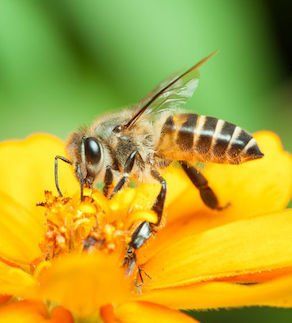What to Do About Bees
What to Do About Bees

It’s spring, a time when bees usually begin to show up, making nests and colonies in places outside your home that are sheltered from the weather. The most common types of bees you’ll likely see are honey bees and bumblebees, and it can be difficult to tell which is which. Bees can also be hazardous due to their ability to sting, but due to their impact on the ecosystem, should not be eradicated in the same way as other pests. Here’s what you need to know about these insects.
Honey Bees
As their name suggests, honey bees are insects that eat the pollen and nectar of flowers and many different kinds of plants. They then regurgitate it to create honey, which they store in their hives. Here are some facts about honey bees:
- Honey bees pollinate over a hundred different crops throughout the United States, though many varieties are endangered or threatened. This is why, in spite of the potential danger they can pose to humans, it’s essential that they are protected.
- Honey bees are generally yellow and black in color, with six legs and light-colored hairs covering their entire bodies. They also have distinctive brown/black and yellow colored bands on the backsides of their abdomens, and they can be ½ to ⅝ inch long.
- The two main kinds of honey bees are Western or European honey bees and Africanized honey bees. European honey bees are larger and more docile while Africanized honey bees are smaller but more aggressive in protecting their nests and young.
- Honey bees are social insects that live in colonies with caste systems made up of queens, drones, and worker bees. Drones are male, while queens and worker bees are female. Only queen honey bees and worker honey bees have stingers, but they are barbed and will come off the bee if it does sting.
- If you get a honey bee sting, it’s important to remove the stinger as quickly as possible to avoid any further injury or effects from the bee’s venom. It’s best to remove a stinger with tweezers to ensure you are able to remove the entire stinger, as infections and other irritations can occur if the stinger is not fully or correctly extracted.
Bumblebees
Bumblebees are remarkably similar to honey bees except for a few key differences, as follows:
- Bumblebees are usually larger, and have stubby wings, though they look similar in terms of coloring.
- They also play an important role in pollination, and draw nectar from plants to make honey. However, they don’t make as much honey as honey bees do.
- Bumblebees have the same kind of social hierarchy as honey bees, and only female bumblebees have stingers. Unlike honey bees, though, bumblebee stingers remain attached to them when they sting, meaning they can sting more than once.
Bee Habitats and Behaviors
Both honey bees and bumblebees build nests in various places that are sheltered from the elements, whether close to the ground or elevated. They may live in overturned plant pots, in openings in trees and anywhere else they can find a secluded spot. Unfortunately, this means they may also find places around your home to build nests, such as in attics, ceilings, open garages, sheds and crawl spaces.
Avoiding Bee Problems
For people interested in keeping bees away from their homes and children, it’s a good idea to take steps to remove potentially attractive plants from close to your home, and let bees settle elsewhere. Keep gardening areas and other plants that you take care of outdoors in safe, designated locations away from children. If you find that bees are gathering near your home in large numbers, don’t try to handle the situation yourself. Contact us to remove them for you, as removing a bee nest can be highly dangerous to anyone besides a professional. At 24 Hour On Call Pest Control, we provide free inspections, so you can rest assured that we will take care of your bee problem quickly and efficiently.
How We Can Help
At 24 Hour On Call Pest Control, our trained professionals will analyze your pest control needs and come up with a personalized plan for your household. Our team of expert technicians will provide a free inspection and work to create a plan to eliminate your pests. At 24 Hour On Call Pest Control, we help homeowners just like you get rid of pests in their homes all year round. If you find that you are having a problem with insects or pests, and need an exterminator, call 24 Hour On Call Pest Control at (855) 420-8572 to schedule a professional evaluation. We can help you get rid of these invaders in your home or office!
We hope you and your loved ones stay well and healthy during this time. We are open and following all CDC regulations. Please call us today for all of your pest control needs!
-
Popular Cities
-
Popular Category










